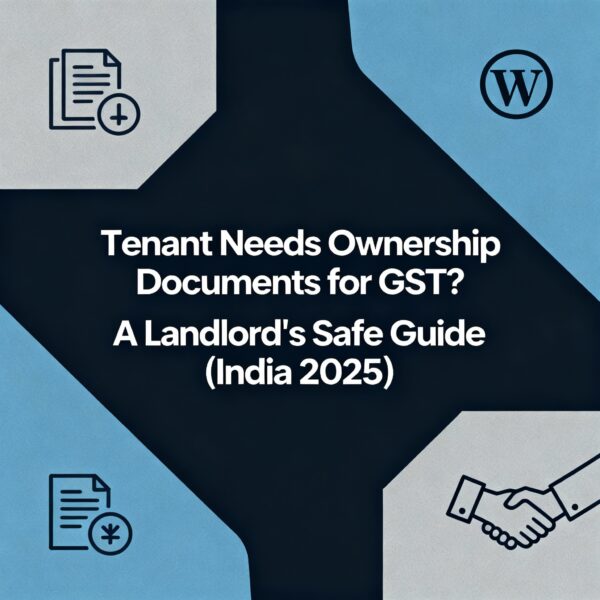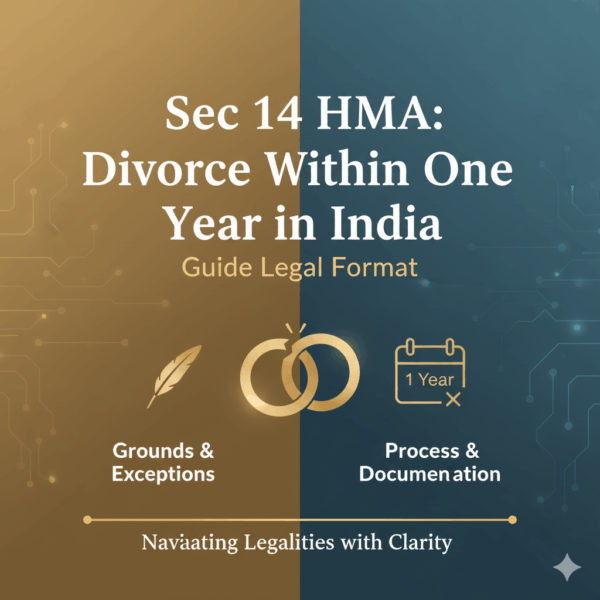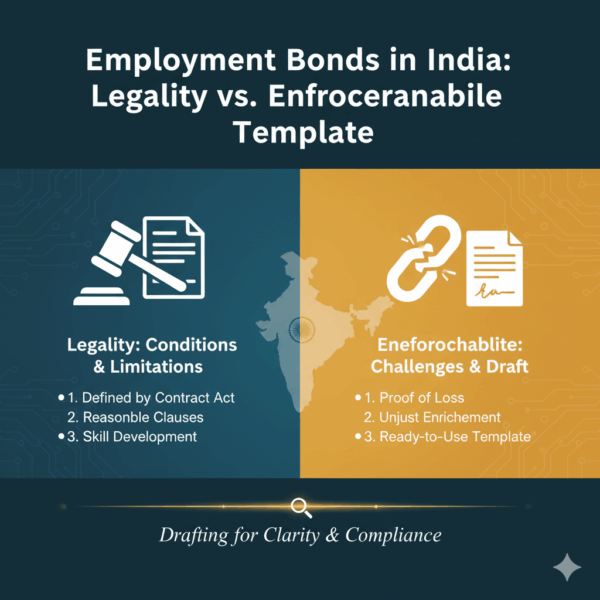This legal guide explains India’s new bank locker liability rules. We cover the RBI’s 100x rent liability cap, the critical ‘Act of God’ exclusion for floods or earthquakes, and the exact steps to take if your items are stolen or missing.
Legal Liability and Financial Risk in Bank Locker Agreements in India
Updated: October 2025. This guide explains the new RBI rules, the 100x rent liability cap, and what to do if your valuables are stolen or lost in a natural disaster.
For decades, bank lockers were seen as the safest place to store gold, documents, and heirlooms. Customers believed their valuables were fully protected by the bank. However, recent RBI guidelines and key court judgments have completely changed this. Your bank is no longer a full insurer of your locker’s contents. In fact, in most cases of loss, the bank’s liability is surprisingly limited.
This guide explains the new legal reality of bank lockers in India. We will cover the bank’s limited liability, your legal rights, and the essential steps you must take to protect your valuables.
The New RBI Rules: What Changed?
Following the Supreme Court’s 2021 ruling in the *Amitabha Dasgupta vs. United Bank of India* case, the RBI issued new, mandatory guidelines for all banks. These rules, which were fully implemented by January 1, 2023, introduce both new protections and new limitations.
- Physical Security: Banks must install CCTV with 180-day storage at all entry and exit points of the vault room.
- Digital Access: Banks must send an SMS and email alert to you every time your locker is operated. This creates a digital trail.
- Transparency: Banks must have a “Model Locker Agreement” (which we will cover) and must display a complete list of available lockers and wait-list numbers.
- Liability Cap: The rules introduce a specific cap on the bank’s liability in case of negligence. This is the most important change.
Decoding the Model Locker Agreement
When you signed your new locker agreement, you agreed to several key clauses. Most customers sign this document without reading it. Here are the parts you must understand.
| Clause | What It Means for You |
|---|---|
| KYC (Know Your Customer) | You must keep your KYC details (Aadhaar, PAN, Address) updated. If your KYC is non-compliant, the bank can freeze your locker’s operation. |
| Payment of Rent | Rent is collected in advance. If you fail to pay rent for three consecutive years, the bank has the right to break open your locker. |
| Prohibited Items | You have declared that you will not store cash, currency, or any illegal or hazardous items. Storing these items automatically voids any claim. |
| Locker Operation | You must operate your locker at least once a year. If the locker remains inoperative for seven years (and rent is unpaid), the bank can also break it open. |
| Bank’s Liability | The agreement will state the bank is only liable for negligence and that its liability is limited to 100 times the annual rent. It will also state the bank is *not* liable for “Acts of God.” |
| Termination | The bank can terminate your agreement with a notice period. This is rare but legally possible. |
When is the Bank Liable? Part 1: Negligence
The RBI has defined when a bank is responsible for loss. This happens due to the bank’s “shortcomings, negligence, and by any act of omission/commission.”
This includes events like:
- Theft or robbery at the branch.
- Fire originating from the bank’s systems (e.g., faulty wiring).
- Building collapse due to the bank’s failure to maintain the premises.
- Fraud committed by a bank employee.
The 100x Annual Rent Liability Cap
If you can prove the bank was negligent and one of the events above occurred, the bank must pay compensation. This compensation is not for the full value of your lost items.
The bank’s liability is strictly capped at an amount equal to one hundred times the prevailing annual rent for your locker. If your rent is Rs. 4,000, the maximum payout you can get from the bank is Rs. 4,00,000, even if you lost Rs. 40,00,000 in gold. This compensation is also not automatic. The burden of proof is on you, the customer.
When is the Bank NOT Liable? Part 2: “Act of God”
This is the most critical and least understood part of the new rules. The bank is not liable for any loss caused by natural disasters or “Acts of God.”
This includes, but is not limited to:
- Floods
- Earthquakes
- Lightning strikes
- Tsunamis
- Riots or civil commotion
If a flood submerges the bank branch and destroys the contents of your locker, your bank is legally not required to pay you any compensation. This risk is now entirely yours.
Similarly, the bank is not liable for loss caused by the “sole fault or negligence of the customer,” such as losing your key or not locking the locker properly.
The Only Exception: “Appropriate Care”
This “Act of God” exclusion has one small exception. The RBI states that banks must “exercise appropriate care” to protect their premises from such events. This provides a narrow legal path. For example, if a bank builds a new vault in the basement of a branch in a known flood-prone area, one could argue it failed to exercise “appropriate care.” This foreseeable negligence could make the bank liable, but the payout would still be capped at 100x the rent.
Liability Matrix: Bank vs. Customer
| Scenario of Loss | Who is Liable? | Maximum Payout |
|---|---|---|
| Bank Robbery or Theft | Bank (due to negligence) | Capped at 100x annual rent |
| Fire (Bank’s Fault) | Bank (due to negligence) | Capped at 100x annual rent |
| Employee Fraud | Bank (due to negligence) | Capped at 100x annual rent |
| Flood or Earthquake | Customer (Act of God) | Zero |
| Riots or Terrorism | Customer (Act of God) | Zero |
| Customer loses key | Customer (negligence) | Zero |
The “Protection Gap” Calculator
This new liability cap creates a massive “Protection Gap” for most customers. Use this interactive chart to visualize your personal gap. Enter your locker’s annual rent and the estimated value of its contents.
Your Action Plan: How to Protect Your Valuables
Since the bank’s liability is so low, the responsibility is on you. Here is a clear, step-by-step plan.
Get a Valuation and Make an Inventory
This is the most important step. Hire a registered valuer and get a detailed, itemized list of all your jewellery with photos. This document is essential for insurance claims and legal cases. Update this list every 2-3 years.
Buy Third-Party Locker Insurance
This is the *only* way to protect against the “Act of God” gap. Several insurance companies (like Tata AIG, IFFCO-Tokio) now offer specific “Locker Insurance” policies. These policies cover losses from floods, earthquakes, and riots that your bank will not.
Operate Your Locker Periodically
Operate your locker at least once every 12-18 months. This creates a fresh digital record (via SMS/email) and prevents the bank from classifying your locker as “inoperative,” which could lead to it being broken open.
Set Up Nomination and Survivorship
This is crucial for your heirs. A nomination is good, but a “survivorship” clause is better. It allows the surviving joint-holder to access the locker without a complex legal process. We will cover this in detail later.
The Dos and Don’ts of Bank Locker Operation
The “Dos”
|
The “Don’ts”
|
The Bank’s Right to Break Open a Locker
A bank cannot break open your locker just because it wants to. The RBI has a strict, formal procedure that banks must follow. This right is typically exercised in two situations: default on rent or an inoperative locker.
The process is as follows:
- Rent Default: If you fail to pay rent, the bank will send you a reminder. If the rent is not paid for three consecutive years, the bank can proceed.
- Inoperative Locker: If a locker is “inoperative” (not opened) for seven years, and the customer cannot be found (even if rent is paid), the bank can also proceed.
- First Notice: The bank must send a registered letter to your last known address, giving you notice to pay the rent and operate the locker.
- Second Notice & Public Notice: If you do not respond, the bank must send a second, final notice. It must also place a public notice in two newspapers (one English, one local language) before breaking it open.
- The Procedure: The locker must be broken open in the presence of a bank official and two independent witnesses. The entire process must be video recorded.
- Inventory: An inventory of the contents is made. The items are placed in a sealed envelope and held by the bank in safekeeping.
- Sale of Items: The bank can then sell the items at auction to recover its dues (rent, breaking charges). Any remaining amount must be paid to the locker holder.
- ✔ “All-Risk” Policy: This is better than a “named peril” policy. It covers all risks except those specifically excluded.
- ✔ “Act of God” Coverage: The policy must explicitly state it covers loss from floods, earthquakes, and other natural disasters. This is the main reason you are buying it.
- ✔ Sufficient Sum Insured: The policy limit must cover the full replacement value of your items, based on your valuer’s certificate.
- ✔ Home Insurance Extension: Sometimes, you can add your locker contents as an extension to your existing home insurance policy. This is often cheaper.
- ✘ Low “Sub-Limits”: A policy might offer a Rs. 20 lakh limit, but have a “sub-limit” of only Rs. 2 lakh for jewellery. This is a common trap.
- ✘ “Theft-Only” Policies: Be careful of cheap policies that only cover theft but exclude fire, floods, or building collapse.
- ✘ Common Exclusions: All policies will exclude cash, currency, and unappraised items. Do not expect to be paid for items not on your inventory list.
- ✘ “First Loss” Basis: Some policies only pay on a “first loss” basis, meaning they only pay a percentage of the total loss. Avoid this if possible.
- Do Not Move: Do not leave the locker room. Do not close the locker.
- Alert the Manager: Immediately call the Branch Manager *into* the locker room. Show them the situation.
- File an FIR: Go to the nearest police station and file a First Information Report (FIR) for theft. This is non-negotiable and is your most important document.
- Written Complaint: Submit a formal, written complaint to the bank, attaching a copy of the FIR. In this complaint, you must formally request the bank to “preserve all CCTV footage” from the vault.
- Escalate: The bank will likely investigate and may deny negligence. You must then follow the escalation path.
- Theft or Robbery: Failure of the bank’s security systems or procedures.
- Fire: A fire caused by the bank’s faulty wiring, un-serviced air conditioning, or negligence.
- Building Collapse: If the bank failed to maintain the building structure, leading to its collapse.
- Employee Fraud: A bank employee uses their access to steal from lockers.
- Failure to Secure Premises: E.g., not following RBI rules on CCTV, alarms, or vault security.
- Natural Disasters: Floods, earthquakes, tsunamis, or lightning strikes.
- External Events: Riots, terrorism, or acts of war.
- Customer Negligence: You lose your key and someone else uses it.
- Customer Fault: You forget to lock the locker properly after operating it.
- Prohibited Items: You stored cash, which was lost. The bank has zero liability for prohibited items.
- Your bank locker is a security box, not an insurance policy.
- The bank’s liability is capped at 100x rent and only applies to its own negligence.
- The bank has zero liability for “Acts of God” like floods or earthquakes.
- You must buy a separate locker insurance policy to cover this “Act of God” risk.
- You must maintain a detailed, valued inventory (with photos) of your items.
- You must add a nominee or a joint holder with a survivorship clause.
Nomination, Survivorship, and Access for Heirs
One of the biggest challenges families face is accessing a locker’s contents after the holder’s death. Planning for this is essential. There are three primary scenarios, each with very different outcomes.
| Access Type | Who Can Access? | Procedure | Speed |
|---|---|---|---|
| Joint Holder with Survivorship | The surviving joint holder(s). | The survivor presents the death certificate. The bank grants access almost immediately. The contents pass to the survivor. | Excellent (1-2 Days) |
| Nomination Only | The person named as the nominee. | The nominee presents the death certificate and their own KYC. The bank grants access. Note: The nominee is a *trustee*, not an owner. They must distribute the assets to the legal heirs. | Good (7-14 Days) |
| No Nomination or Survivor | The legal heirs (as per a Will or Succession Act). | This is a complex, long, and expensive legal process. Heirs must produce a Will, a probate order, or a Letter of Administration/Succession Certificate from a court. | Extremely Poor (6 Months – 2 Years+) |
How to Choose a Bank Locker Insurance Policy
Since the bank’s “Act of God” exclusion creates a major risk, a third-party policy is essential. But not all policies are the same. Use this checklist when buying one.
What to Look For (The “Dos”) |
What to Avoid (The “Don’ts”) |
What to Do if You Find Items Missing
This is a worst-case scenario. If you open your locker and find items missing, do not panic. Follow these steps precisely and immediately.
Your Escalation Path (If the Bank Denies Your Claim)
If the bank refuses to cooperate or denies your claim, do not give up. Follow this formal escalation hierarchy.
| Level 1 | The Branch Manager Submit your formal written complaint with the FIR copy. Get a written acknowledgment (a “stamp and sign”) on your copy. |
| Level 2 | Bank’s Nodal Officer / Head Office If you get no response in 7-10 days, escalate to the bank’s designated Nodal Officer for customer complaints. Their details are on the bank’s website. |
| Level 3 | The RBI Ombudsman If the bank does not resolve your complaint within 30 days, you can file a complaint with the RBI Banking Ombudsman. This is a free and powerful service. |
| Level 4 | The Consumer Court (NCDRC) Your final recourse is to file a case with the District, State, or National Consumer Disputes Redressal Commission (NCDRC) for “deficiency of service.” Your inventory list and FIR will be your key evidence. |
What to Do if Items are Missing: A Visual Guide
If you face the distressing situation of finding items missing, the first few hours are critical. The process involves legal and banking procedures that must be followed in a specific order. This D3.js flowchart visualizes the exact steps you must take to protect your rights.
Interactive Liability Scenarios
The rules on liability can be confusing. Use this tool to see the most common scenarios and who is held responsible.
The bank is liable for its own proven negligence. This includes:
In all these cases, compensation is capped at 100x the annual rent.
The bank is NOT liable for external events or customer faults. This includes:
In all these cases, the bank’s liability is zero.
Final Recommendations: A Summary
The bank’s vault provides physical security. You are responsible for the financial security.
Conclusion
The legal landscape for bank lockers in India has fundamentally shifted. The new RBI rules provide enhanced physical security, such as CCTV and biometric access, which is a significant improvement. However, these same rules legally define the bank’s limited financial liability, capping it at 100 times the annual rent and excluding all “Acts of God.”
This creates a clear reality for customers: a bank locker is for safekeeping, not for financial insurance. The responsibility for protecting the actual value of your contents now rests entirely with you. A proactive strategy of maintaining a detailed inventory, operating the locker periodically, and securing comprehensive third-party insurance is no longer optional. It is the only way to ensure your valuables are truly protected.
Frequently Asked Questions (FAQ)
Q: Can I store cash in my bank locker? Is it illegal?
A: It is not “illegal,” but it is against the Model Locker Agreement you signed. The agreement explicitly prohibits storing cash or currency. If your locker is broken into and you claim you lost Rs. 5,00,000 in cash, the bank has zero liability. You have violated the terms of the contract.
Q: What is the difference between a nominee and a legal heir?
A: A nominee is a “trustee” or “custodian.” The bank gives the locker contents to the nominee, whose job is to then distribute them to the legal heirs (as defined by a Will or the Succession Act). A legal heir is the actual, legal owner of the assets. If your nominee is also your only legal heir, the process is simple.
Q: What happens if I lose my locker key?
A: You must report it to the bank immediately in writing. The bank will have to break open the locker (at your expense) and replace the lock. This entire process is chargeable, and the cost can be several thousand rupees.
Q: My bank is forcing me to take a Fixed Deposit (FD) to get a locker. Is this legal?
A: Yes, the RBI allows this. Banks are permitted to take a “term deposit” (Fixed Deposit) at the time of allotment. This deposit can cover the rent for three years plus the charges for breaking open the locker in case of an event. This is to ensure the bank can recover its dues if you abandon the locker.
Q: The bank says my new locker agreement is “not ready.” Am I covered by the new rules?
A: Yes. The RBI has stated that all banks must comply with the new rules, and the responsibility for executing the new agreement was on them. Even if you have not signed the new paper, the new RBI guidelines on liability (the 100x cap) and security (CCTV) apply to all lockers as of January 1, 2023.
Q: Does my home insurance cover my locker contents?
A: Usually, no. A standard home insurance policy only covers items *inside your home*. However, you can often buy an “add-on” or a “rider” to your home insurance to cover the contents of your bank locker. This is often cheaper than a brand-new, standalone locker policy. Check with your insurance provider.
Template Letters for Your Use
Here are two important templates. Click the button to copy the text, then paste it into a document and fill in your details.
1. Template: Letter to Police for Filing FIR
To, The Station House Officer (SHO), [Police Station Name], [Police Station Address], Date: [Date] Subject: Filing of First Information Report (FIR) regarding missing items from my bank locker. Respected Sir/Madam, I, [Your Full Name], resident of [Your Address], hold a safe deposit locker, [Locker Number], at [Bank Name], [Branch Address]. On [Date of Visit], at approximately [Time of Visit], I visited the bank to operate my locker. Upon opening it in the presence of the bank official, [Official's Name, if known], I was shocked to discover that the following items were missing: 1. [Detailed description of Item 1, e.g., Gold necklace, approx. 20 grams, with ... design] 2. [Detailed description of Item 2, e.g., Property documents for ...] 3. [List all other missing items with as much detail as possible] The total estimated value of the missing items is approximately Rs. [Estimated Value]. I have not authorized any other person to operate my locker. The last time I operated the locker was on [Date of Last Visit], and all items were secure at that time. I request you to register an FIR for theft and criminal breach of trust against unknown persons and to investigate this matter urgently. Please provide me with a certified copy of the FIR. My contact details are: Phone: [Your Phone Number] Email: [Your Email Address] Thank you for your prompt action. Yours faithfully, (Signature) [Your Full Name]
2. Template: Letter to Bank Manager (After Filing FIR)
To, The Branch Manager, [Bank Name], [Branch Address], Date: [Date] Subject: Formal Complaint - Missing items from Safe Deposit Locker No. [Locker Number] Dear Sir/Madam, I am writing to file a formal complaint regarding the loss of valuable items from my locker, [Locker Number], which I hold at your branch. On [Date of Visit], at [Time of Visit], I opened my locker and discovered that items (list attached) were missing. I immediately filed a First Information Report (FIR) with the [Police Station Name] police. A copy of the FIR (No. [FIR Number], dated [Date of FIR]) is attached for your records. This incident constitutes a clear failure in your duty of care and negligence by the bank in ensuring the safety of the vault. I formally request that you: 1. Immediately preserve all CCTV footage of the locker room and vault area from [Date of Last Visit] to [Date of Visit]. 2. Initiate a thorough internal investigation into this matter. 3. Provide me with a written acknowledgment of this complaint and the steps your investigation will take. 4. Compensate me for the loss, as this is a result of the bank's negligence. Please treat this matter with the utmost urgency. Sincerely, (Signature) [Your Full Name] A/C No: [Your Account Number] Phone: [Your Phone Number]









